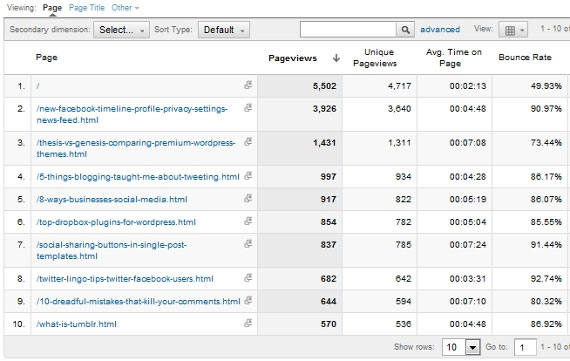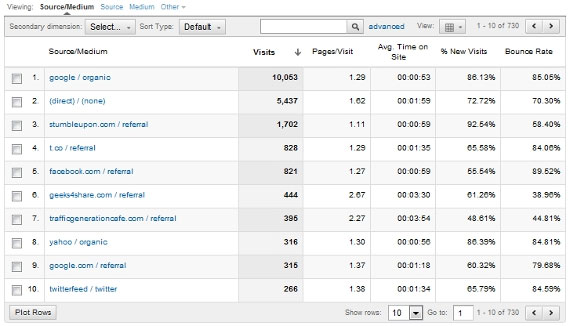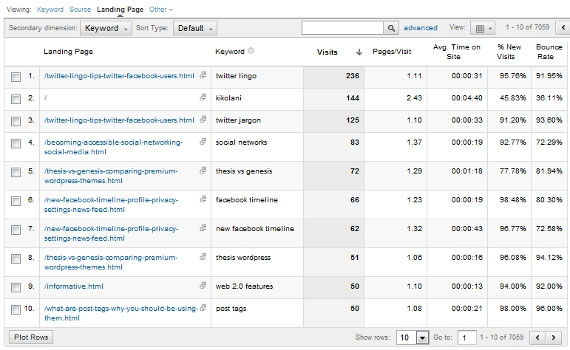What are bounce rates and how to improve them?
Bounce rate is the ratio of visitors to your website and then immediately leave without seeing any other pages. If you look at Google Analytics, you will see this percentage. An average Bouce rate of 75% means that 75% of visitors come to the site and leave after seeing only the first page they are exposed to whether it is the homepage or subsite.
From that we draw the fact that your website does not retain visitors. Visitors to websites have 2 possibilities:
- One is, finding what they want in addition does not have anything to keep them attached to.
- Second, they don't find what they need on your website.
The issue you need to consider is to make sure a visitor coming to a Landing Page will be attracted to and visit more pages.
Learn about bounce rate
- Having a high Bouce rate is really a bad thing
- Improve Bounce rate with Google Analytics
- Best keywords
- Other data related to Bounce rate
- How to improve Bounce rate?
- Optimize the loading speed
- Web design compatible mobile devices
- Add links to more pages in the content of the website.
- Content improvement
- Add visual elements
- Stay away from ads
- Makes search and navigation easy
- Smooth UX creation
Having a high Bouce rate is really a bad thing
Before you start, take a moment to think about what if your website has a high bounce rate. Is that a bad thing?
Sites whose purpose is not to want visitors to browse page after page, instead they want them to interact with the call to action buttons. Calls to action may cause a visitor to exit the website when doing:
- Call 1-800 (customer care consulting number) to ask about products and services.
- Lead customers to a site that sells products on another domain or network like you would on Ebay.
- Click on PPC banner ads to lead to an affiliate marketing site.
- Fill out a form without directing the visitor to another page to confirm.
Basically, if your goal only requires people to visit a certain page on the website, you don't have to worry about bounce rate unless the goals are completed far lower than the number of people leaving the website after viewing a page. .
We can say Bounce Rate is a measure to say the quality of a website. A website has a low Bounce Rate, which proves that the website is useful to the majority of visitors. And so advertisers often choose low Bounce Rate websites to run their advertising campaigns, which means you'll get an additional revenue stream from allowing ads on my site.
Improve Bounce rate with Google Analytics
The first stop in understanding how to reduce the bounce rate is in Google Analytics. When you log into your website's GA account, right before your eyes is an average Bounce rate. Find out where this average figure comes from. Here are a few things you can learn from bounce rate through Analytics.
Firstly, you will go into Content -> Site content -> All page.

Here you will see the pages on the website that have received the most views in the last 30 days with a corresponding Bounce rate. Here you can see that:
The bounce rate of the homepage is slightly less than 50%. This means that at least half of visitors to the homepage have moved to another article or other pages on the website.
This month's most popular post about Facebook Timeline has a Bounce rate of 91% after people read this post they are satisfied with and exit.
You can then sort the Bounce rate from high to low by clicking on that column. This information can help you identify:
- What content leads visitors to more pages on the website, what content is the first and last place that visitors see.
- Which page on the website needs to improve first, usually you want to improve the bounce rate of pages with high pageview. If you reduce the bounce rate on the pages with the most traffic, it will transfer the maximum number of visitors to other pages on your website.
- Which page should you learn how to retain visitors longer. Sites with a low Bounce rate will almost certainly be able to lead visitors to other areas of the website best.
Next you will go to Traffic source -> All traffic

Here you will see which sources of visitors have brought most visitors to your site along with the corresponding bounce rate. What we can quickly see is:
- Geeks4share.com and TrafficGennerationcafe.com topped with the lowest Bounce rate. Visitors from these sites are likely to dig deeper into the website.
- Stumbleupon is the strongest social network pointing to the website with the lowest bounce rate compared to Facebook and Twitter.
- Facebook is surprisingly the traffic source with the highest bounce rate.
This section can tell you which traffic sources bring visitors to your website. It can tell you whether you are satisfying a visitor on one channel or another. In this case, the website offers content that Stumbleupon users benefit more than Facebook users. And it can tell you which traffic sources to focus on if your goal is to keep and grow more visitors on your website.
Best keywords
Going deeper into the Traffic Source, under the Search -> Organic section you can see which keyword brings the most visitors to the website through natural search with the corresponding Bounce rate. You can even see the Landing Page page that keywords lead visitors by clicking on the Landing Page menu above and then selecting keyword (under the Traffic Source section) in the Secondary Dimension menu as a result:

This way, if you have different keywords that lead to the same page, you can see if searchers are getting the information they want on relevant Landing Pages, and which keywords. make them want to continue browsing the website based on the content of that Landing Page.
Other data related to Bounce rate
From start to finish Google Analytics , most data information is related to bounce rate. Continue to research Google Analytic to find out demographic factors such as location, browser type, type of social network involved in the bounce rate of the website.
How to improve Bounce rate?
Now you have studied Content, Traffic Source, Keywords, demographic data and the relevance of the factors to Bounce rate. The next question will surely be how to improve Bounce rate?
Here are the suggestions for you:
Optimize the loading speed
Today's users do not have the patience to wait to access the webstie readers to read information because they have so many choices between the sea of information that Google provides. If the website loads for too long, they will probably immediately exit to your competitors' websites.
Web design compatible mobile devices
The percentage of people using mobile devices to access the Internet is increasing daily, if your website does not display properly with your phone, tablet . they will also exit when surfing some key information without want to bother looking at other interesting information on the website.
Add links to more pages in the content of the website.
Think about the relevant pages in the website that you think visitors will be interested in, link to them with contextual keywords or at the end of each article use transitional sentences' if you like this article you might as well interested in the lesson . '
Content improvement
If you notice that the problem with content is not only a high bounce rate but also a low 'time on site ' (meaning people are escaping very quickly) then it is possible that your content is not providing get what the visitor wants. Take a look at high bounce rate + low on time sites and find ways to provide more valuable information to keep visitors on the page (like videos) long enough for them to realize that your website has a lot of interesting things. Should not exit immediately.
 Provide content that is truly relevant to what users are looking for
Provide content that is truly relevant to what users are looking for The ideal bounce rate will likely fluctuate significantly according to the page visited as well as the traffic source. For example, new visitors rooted in organic (organic) search may not be as familiar to your brand as customers from other digital marketing channels (such as adwords and email).
Because new visitors may not know what you have to offer, you will have to work a little harder to keep this audience on the site. The best way to do this is to make sure each landing page satisfies the search purpose.
In other words, provide relevant content. When you do keyword research and map them to each page, consider: Is your page a perfect match for each keyword? Don't fall into the trap of optimizing pages for high-risk words, when the content is really targeted to the long-tail keyword.
When you do keyword research, check the search engine results page for that keyword. Click on each rating page and rate its content. Does your content match what you see?
If you've posted your content and are checking the results, use Search Console and note the queries that are sending people to sites with bad bounce rates. Does the page fit those queries? How can you tailor content to make it more relevant? Again, check the search engine results page for each query and see how other top ranking sites are handling the query.
Add visual elements
Long content with nothing wrong. But if you only see the full text when you visit the site, visitors will not be excited and stay long. Adding eye-catching images and intriguing visual elements to users will keep them engaged, even before starting to read the content.
Stay away from ads
Think about the last time you did a search and went to a website filled with ads. How long did you stay?
There are many reasons a website that is so heavy in advertising can reduce visitor trust. Ads can slow down page loading speed and lead to terrible user experience. They cause a lot of visual clutter and make the site look like it's intended for advertisers, not readers.
 Ads must not overwhelm the content
Ads must not overwhelm the content Blogs and websites do not necessarily eliminate ads altogether, but the ads must not overwhelm the content.
And if your site is an ecommerce site, beware of notification bars, pop-ups and even live chat. Always give people a quick way to close a pop-up window when needed and don't make it appear annoying.
Makes search and navigation easy
Suppose the user visits a page and it is not exactly what they are looking for, but the user will still stay if the page has enough factors to convince the user that they are very close to what they need. already. Do users have a quick way to find what they really need? Make sure the site's navigation system is logical and streamlined, able to effectively guide users no matter which page they start on.
If a user comes to the page with an incorrect product, searching the web for the right product is most likely the next step they take. Make sure the site search feature is clearly visible and easy to use. Consider integrating an autocomplete search system with products or content.
Smooth UX creation
Content on the page may be perfect, but a poor UX can still lead to a visitor abandoning the page. Take a look at pages with high bounce rates and rate them on basic UX elements. Look at page load speed, functionality, consistency, layout, animation or motion on the page and any expectations from site visitors based on the actions they perform (scroll, hover, click, pinch, swipe, etc).
Then dig deeper, see where users stop scrolling, what they click, how long they stay on this page and where they lose their focus, then address those problem areas.
 What is Fluent Design?
What is Fluent Design? What is HDR? What is the difference between HDR formats?
What is HDR? What is the difference between HDR formats? What is Intel Turbo Boost? How does Intel Turbo Boost work?
What is Intel Turbo Boost? How does Intel Turbo Boost work? What is RStudio? Why use RStudio?
What is RStudio? Why use RStudio? What is Windows PATH?
What is Windows PATH? What is mDNSResponder.exe / Bonjour and how to uninstall it from the computer
What is mDNSResponder.exe / Bonjour and how to uninstall it from the computer